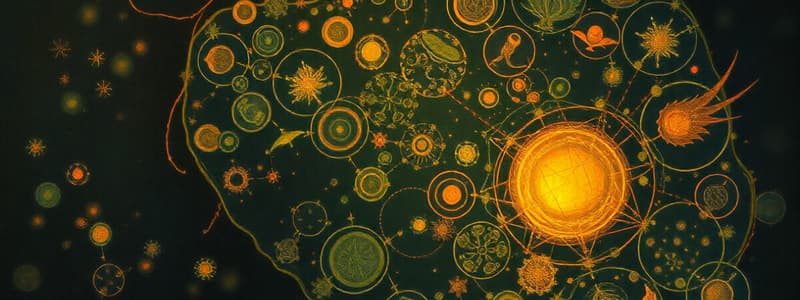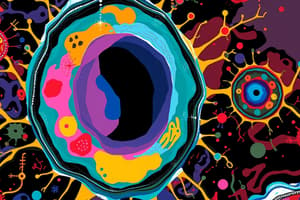Podcast
Questions and Answers
Which statement describes a fundamental aspect of the cell theory?
Which statement describes a fundamental aspect of the cell theory?
- Cells can arise from spontaneous generation.
- Cells are unaffected by their environment.
- All living organisms are composed of one or more cells. (correct)
- All cells must contain a nucleus.
Which function of life is primarily concerned with the removal of waste products?
Which function of life is primarily concerned with the removal of waste products?
- Homeostasis
- Nutrition
- Excretion (correct)
- Response
What is a common characteristic shared by all cells?
What is a common characteristic shared by all cells?
- Uniform size and shape.
- Dependence on external energy sources.
- Presence of organelles for photosynthesis.
- Surrounded by a membrane. (correct)
How does genetic material exist within a cell?
How does genetic material exist within a cell?
Which type of cell is specifically associated with oxygen transport in the human body?
Which type of cell is specifically associated with oxygen transport in the human body?
Enzymes in a cell serve what primary role?
Enzymes in a cell serve what primary role?
What distinguishes unicellular organisms from multicellular organisms?
What distinguishes unicellular organisms from multicellular organisms?
Which of the following best describes filamentous algae?
Which of the following best describes filamentous algae?
Nerve cells are primarily responsible for which function?
Nerve cells are primarily responsible for which function?
Which of the following statements is true regarding the diversity of cells?
Which of the following statements is true regarding the diversity of cells?
Which statement correctly describes a prokaryotic cell?
Which statement correctly describes a prokaryotic cell?
Which of the following is a characteristic of archaea?
Which of the following is a characteristic of archaea?
Which domain contains true bacteria?
Which domain contains true bacteria?
What distinguishes eubacteria from archaea?
What distinguishes eubacteria from archaea?
Which of these bacteria is an example of a photo-synthesizer?
Which of these bacteria is an example of a photo-synthesizer?
What best defines a theory in scientific investigation?
What best defines a theory in scientific investigation?
What happens to a theory when serious discrepancies are found?
What happens to a theory when serious discrepancies are found?
Which of the following best describes the concept of 'cell diversity'?
Which of the following best describes the concept of 'cell diversity'?
In scientific terms, how are generalizations and predictions formed?
In scientific terms, how are generalizations and predictions formed?
What characterizes atypical cells in relation to the cell theory?
What characterizes atypical cells in relation to the cell theory?
What structure is found in eukaryotic cells but not in prokaryotic cells?
What structure is found in eukaryotic cells but not in prokaryotic cells?
What is the primary location of genetic material in prokaryotic cells?
What is the primary location of genetic material in prokaryotic cells?
Which of the following is a characteristic of prokaryotic cells?
Which of the following is a characteristic of prokaryotic cells?
Which of the following organelles is unique to eukaryotic cells?
Which of the following organelles is unique to eukaryotic cells?
What feature distinguishes prokaryotic cells from eukaryotic cells?
What feature distinguishes prokaryotic cells from eukaryotic cells?
What is the approximate size of a red blood cell in micrometers?
What is the approximate size of a red blood cell in micrometers?
Which shape is characteristic of a fat cell?
Which shape is characteristic of a fat cell?
Which of the following cell types is the largest based on the data provided?
Which of the following cell types is the largest based on the data provided?
What shape do bacillus bacteria exhibit?
What shape do bacillus bacteria exhibit?
Which cell type has a long and branched structure resembling a tree?
Which cell type has a long and branched structure resembling a tree?
Flashcards
Cell Theory
Cell Theory
All living things are made of cells, cells come from pre-existing cells, and cells are the basic unit of life.
Functions of Life
Functions of Life
Essential activities for an organism to survive (nutrition, metabolism, growth, response, excretion, homeostasis, reproduction).
Cell Membrane
Cell Membrane
The outer layer surrounding every living cell.
Genetic Material
Genetic Material
Signup and view all the flashcards
Cell Nucleus
Cell Nucleus
Signup and view all the flashcards
Red blood cell function
Red blood cell function
Signup and view all the flashcards
Unicellular organism
Unicellular organism
Signup and view all the flashcards
Chlamydomonas size
Chlamydomonas size
Signup and view all the flashcards
Multicellular organization
Multicellular organization
Signup and view all the flashcards
Cell Diversity
Cell Diversity
Signup and view all the flashcards
Prokaryotic Cell
Prokaryotic Cell
Signup and view all the flashcards
Prokaryotic Cell Structure
Prokaryotic Cell Structure
Signup and view all the flashcards
Prokaryotic Domains
Prokaryotic Domains
Signup and view all the flashcards
Bacteria Examples
Bacteria Examples
Signup and view all the flashcards
Archaea Characteristics
Archaea Characteristics
Signup and view all the flashcards
Atypical Cell
Atypical Cell
Signup and view all the flashcards
Exceptions to a Theory
Exceptions to a Theory
Signup and view all the flashcards
Scientific Investigation
Scientific Investigation
Signup and view all the flashcards
Nucleoid
Nucleoid
Signup and view all the flashcards
What are the main differences between prokaryotic and eukaryotic cells?
What are the main differences between prokaryotic and eukaryotic cells?
Signup and view all the flashcards
What are some examples of eukaryotic cells?
What are some examples of eukaryotic cells?
Signup and view all the flashcards
Micrometer (µm)
Micrometer (µm)
Signup and view all the flashcards
Cell Size Variations
Cell Size Variations
Signup and view all the flashcards
Red Blood Cell Shape
Red Blood Cell Shape
Signup and view all the flashcards
Amoeba's Shape
Amoeba's Shape
Signup and view all the flashcards
Bacterial Shapes
Bacterial Shapes
Signup and view all the flashcards
Study Notes
The Cell Theory
- All living things are made up of cells (one or more).
- Cells can arise only by division from pre-existing cells.
- The cell is the basic unit of life (the smallest living structure).
Functions of Life
- The functions of life are things that all organisms must do to stay alive.
- Nutrition
- Metabolism
- Growth
- Response
- Excretion
- Homeostasis
- Reproduction
Cell Theory
- Cells vary in shape and size but share common features.
- Every living cell is surrounded by a membrane.
- A cell contains genetic materials which store all instructions needed for the cell's activities.
- The genetic material may be bounded to form a nucleus or it may be unbound and scattered in the cytoplasm.
- Many of the cell's activities are catalyzed by enzymes.
- Cells have their own energy release system to power cellular activities.
Studying That Suits You
Use AI to generate personalized quizzes and flashcards to suit your learning preferences.
Description
Explore the fundamental concepts of cell theory and the essential functions that sustain life. This quiz covers the characteristics of cells, their structure, and the vital processes necessary for all living organisms. Test your knowledge on nutrition, metabolism, reproduction, and more!





